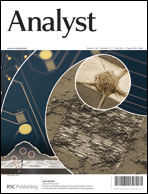Sensitive and high resolution subcutaneous fluorescence in vivo imaging using upconversion nanoparticles and microarrays†
Abstract
A sensitive and high resolution small animal in vivo imaging system using upconversion nanoparticles (UNPs) and microarrays was developed. The fluorescence tomography using UNPs could achieve higher precision than that using ordinary fluorophores, which was theoretically explained by the finite element method (FEM). Given the autofluorescence-insensitive property of UNPs, a high subcutaneous detection sensitivity of 0.93 × 10−4 wt% could be achieved with a UNP volume of ∼10 μL in tissue phantoms. Furthermore, UNP fluorophore microarrays (25, 50 and 100 μm arrays) embedded under mouse skin were prepared for subcutaneous in vivo detection. An optical clearing method was applied to enhance the skin transparency and improve the spatial resolution. The results demonstrated that the optimized system could achieve a spatial resolution of 50 μm for in vivo detection of subcutaneous UNP microarrays. Taken together, we conclude that the proposed system and UNP microarrays could achieve sensitive, high resolution subcutaneous in vivo detection, and have great potential for high throughput detection of tumors and other diseases.


 Please wait while we load your content...
Please wait while we load your content...